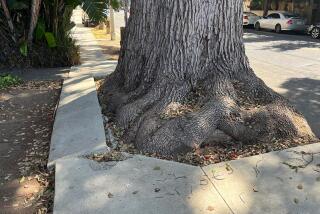BRADLEY’S BATTLE PLAN ON TRAFFIC CONGESTION
- Share via
In June, 1987, Mayor Tom Bradley announced a major program to reduce traffic congestion on Los Angeles streets. Here is a progress report on its provisions: TRUCK BAN About 70% of all trucks would be banned from surface streets during the peak weekday rush hours of 6 to 9 a.m. and 4 to 7 p.m. Large shippers and receivers would be required to operate for at least four hours between off-peak hours. The program would be limited to trucks with three axels or more and a gross weight of more than 26,000 pounds. A rapid deployment force would also be created to remove disabled trucks from the roadway. Approved by City Council Transportation and Finance and Revenue committees this spring; a bill now in state Legislature would preempt city proposal. ILLEGAL PARKING Special teams of traffic control officers would impound vehicles illegally blocking curb lanes during peak commuting hours. Adopted by council August, 1987. Delivery trucks would be given access to off-street parking to reduce illegal street parking during deliveries. Implemented administratively; no ordinance needed. Fines for peak hour “no-stopping” violations would be increased from $28 to $53, with illegally parked cars to be towed away half an hour before the rush hour starts, at 6:30 a.m. and 3:30 p.m. Put into effect by Municipal Court March, 1988. STREET IMPROVEMENTS Additional personnel would be hired to implement more than 100 traffic improvement projects intended to increase capacity and safety by at least 30%; among the improvements are additional left-turn pockets, left-turn restrictions, reverse traffic lanes, peak-hour lanes and traffic signal timing. Adopted by council May, 1988. CITY CREWS Non-emergency work by city crews would be banned during peak hours on posted streets. Established by executive order December, 1987 CONTROL OFFICERS The number of traffic control officers would be increased from fewer than 300 to more than 600. Adopted in the 1988-89 budget. TRAFFIC NEWS City traffic officers, police and firefighters would relay news of traffic troubles to broadcast stations with volunteer help from about 1,000 radio-equipped Federal Express drivers. Adopted in the city’s 1989-90 budget. TRAFFIC SIGNALS A citywide Automated Traffic Surveillance and Control System would be implemented in 10 years rather than in the 30 years originally planned; would automatically monitor the flow of the 400,000 vehicles that go in and out of the downtown area daily, adjust the timing of intersection lights and dispatch emergency crews. Adopted by council December, 1987. BLOCKED INTERSECTIONS Drivers would be banned from entering a blocked intersection, even if the light is green; violators would be fined $53 for a first offense and up to $500 for successive violations. Adopted by council December, 1987; now included in state law. COMMITTEES Local area committees, appointed by the mayor and council, would be set up to consider solutions to local traffic and transportation issues. Adopted by council May, 1988. SUBSIDY Employers in the city that have at least 200 workers would be required to offer $15 bus pass subsidies each month if they also provide subsidized parking; businesses also would be offered up to $5,000 in transit funds to lease or purchase vans for employee van pools. Adopted by council February, 1989. TELEPHONE SYSTEM A toll-free number would be established for information and for lodging complaints on all bus systems, commuter computer car and van pools, local transit and specially equipped vehicles for the elderly and disabled. Adopted in the 1989-1990 budget. RTD Transit services would be improved and buses would be washed inside and out by 200 high school students in the Los Angeles Pride Demonstration Project. Pending PARKING Parking fees for city employees, including elected officials, would be increased from $5 a month to $25 at city-owned or city-leased lots. Adopted by council September, 1988. STAGGERED WORK HOURS Work hours for city employees would be staggered and some employees would be allowed to work part time at home. Approved by the Transportation and Traffic Committee; expected to come before the full council in August. TRANSPORTATION MANAGEMENT ORGANIZATIONS AND ASSOCIATIONS The city would encourage ride-sharing among small companies by subsidizing car-pooling and other traffic-reduction programs.
More to Read
Sign up for Essential California
The most important California stories and recommendations in your inbox every morning.
You may occasionally receive promotional content from the Los Angeles Times.










